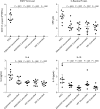Clinical Features and Outcomes of Patients With Symptomatic Kaposi Sarcoma Herpesvirus (KSHV)-associated Inflammation: Prospective Characterization of KSHV Inflammatory Cytokine Syndrome (KICS)
- PMID: 26658701
- PMCID: PMC4772848
- DOI: 10.1093/cid/civ996
Clinical Features and Outcomes of Patients With Symptomatic Kaposi Sarcoma Herpesvirus (KSHV)-associated Inflammation: Prospective Characterization of KSHV Inflammatory Cytokine Syndrome (KICS)
Erratum in
-
Erratum.Clin Infect Dis. 2018 Mar 5;66(6):985. doi: 10.1093/cid/cix831. Clin Infect Dis. 2018. PMID: 29370384 Free PMC article. No abstract available.
Abstract
Background: Kaposi sarcoma herpesvirus (KSHV) is the cause of Kaposi sarcoma (KS), primary effusion lymphoma (PEL), and a form of Castleman disease (KSHV-MCD). Recently a KSHV-associated inflammatory cytokine syndrome (KICS) distinct from KSHV-MCD was reported.
Methods: We prospectively characterized the clinical, laboratory, virologic and immunologic features of KICS by evaluating symptomatic adults with KSHV using a prespecified definition. These features and overall survival were compared with controls from 2 prospectively characterized human immunodeficiency virus (HIV)-infected cohorts, including 1 with KSHV coinfection.
Results: All 10 KICS subjects were HIV infected males; 5 had HIV viral load (VL) suppressed <50 copies mL (median 72, range <50-74 375); all had KS and 2 also had PEL. All had multiple severe symptoms attributable to KICS: median number of symptoms 8 (6-11), median grade of worst symptom 3 (2-4). These included gastrointestinal disturbance (present in 9); edema (9); respiratory (6); and effusions (5). Laboratory abnormalities included anemia (all); hypoalbuminemia (all) and thrombocytopenia (6). None developed KSHV-MCD; 6 died with median survival from KICS diagnosis 13.6 months. KICS subjects compared with controls had more severe symptoms; lower hemoglobin and albumin; higher C-reactive protein; higher KSHV VL; elevated interleukin (IL)-6 and IL-10; and an increased risk of death (all P < .05). Anemia and hypoalbuminemia at presentation were independently associated with early death.
Conclusions: KICS subjects demonstrated diverse severe symptoms, a high rate of KSHV-associated tumors, high mortality, and a distinct IL-6/IL-10 signature. KICS may be an important unrecognized cause of morbidity and mortality, including symptoms previously ascribed to HIV. Exploration of KSHV-directed therapy is warranted.
Keywords: HIV; Human Herpesvirus 8 (HHV-8); IL-10; IL-6; Kaposi sarcoma herpesvirus (KSHV).
Published by Oxford University Press for the Infectious Diseases Society of America 2015. This work is written by (a) US Government employee(s) and is in the public domain in the US.
Figures



References
-
- Chang Y, Cesarman E, Pessin MS et al. . Identification of herpesvirus-like DNA sequences in AIDS-associated Kaposi's sarcoma. Science 1994; 266:1865–9. - PubMed
-
- Cesarman E, Chang Y, Moore PS, Said JW, Knowles DM. Kaposi's sarcoma-associated herpesvirus-like DNA sequences in AIDS-related body-cavity-based lymphomas. N Engl J Med 1995; 332:1186–91. - PubMed
-
- Soulier J, Grollet L, Oksenhendler E et al. . Kaposi's sarcoma-associated herpesvirus-like DNA sequences in multicentric Castleman's disease. Blood 1995; 86:1276–80. - PubMed
-
- Aoki Y, Tosato G, Fonville TW, Pittaluga S. Serum viral interleukin-6 in AIDS-related multicentric Castleman disease. Blood 2001; 97:2526. - PubMed
Publication types
MeSH terms
Substances
Grants and funding
LinkOut - more resources
Full Text Sources
Other Literature Sources
Medical
Research Materials

